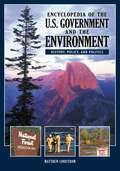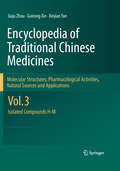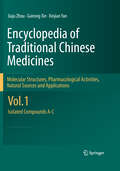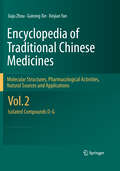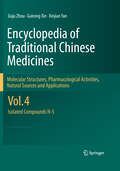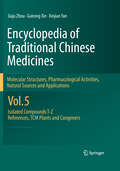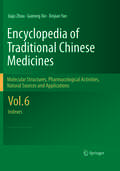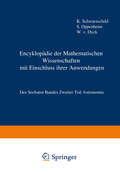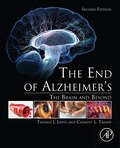- Table View
- List View
Encyclopedia of the U.S. Government and the Environment [2 volumes]: History, Policy, and Politics [2 volumes]
by Matthew J. LindstromA timely, new resource on the history of the U.S. government's approach to environmental policy.At a time when changing the nation's environmental policy is a top presidential priority, with a new global climate change treaty deep in negotiations, and with the country itself weighing the need for action against concerns over too much government regulation, this exhaustive new reference work could not be more welcomed.Encyclopedia of the U.S. Government and the Environment: History, Policy, and Politics explores the interaction between the federal government and environmental politics and policy throughout the nation's history, from the earliest efforts to preserve lands and regulate pollution to the 1960s emergence of the modern environmental movement, the landmark legislation of the 1970s, and the seesawing back-and-forth of policies between alternating Republican and Democrat administrations of the last three decades. Authoritative, unbiased, and informed by the latest available research, the hundreds of entries cover the full range of issues, events, laws, institutions, and key players that shape federal environmental policies, incorporating viewpoints from across the ideological spectrum.
Encyclopedia of Traditional Chinese Medicines - Molecular Structures, Pharmacological Activities, Natural Sources and Applications: Vol. 3: Isolated Compounds H-M
by Jiaju Zhou Guirong Xie Xinjian YanThis set of six volumes provides a systematic and standardized description of 23,033 chemical components isolated from 6,926 medicinal plants, collected from 5,535 books/articles published in Chinese and international journals. A chemical structure with stereo-chemistry bonds is provided for each chemical component, in addition to conventional information, such as Chinese and English names, physical and chemical properties. It includes a name list of medicinal plants from which the chemical component was isolated. Furthermore, abundant pharmacological data for nearly 8,000 chemical components are presented, including experimental method, experimental animal, cell type, quantitative data, as well as control compound data. The seven indexes allow for complete cross-indexing. Regardless whether one searches for the molecular formula of a compound, the pharmacological activity of a compound, or the English name of a plant, the information in the book can be retrieved in multiple ways.
Encyclopedia of Traditional Chinese Medicines - Molecular Structures, Pharmacological Activities, Natural Sources and Applications: Vol. 1: Isolated Compounds A-C
by Jiaju Zhou Guirong Xie Xinjian YanThis set of six volumes provides a systematic and standardized description of 23,033 chemical components isolated from 6,926 medicinal plants, collected from 5,535 books/articles published in Chinese and international journals. A chemical structure with stereo-chemistry bonds is provided for each chemical component, in addition to conventional information, such as Chinese and English names, physical and chemical properties. It includes a name list of medicinal plants from which the chemical component was isolated. Furthermore, abundant pharmacological data for nearly 8,000 chemical components are presented, including experimental method, experimental animal, cell type, quantitative data, as well as control compound data. The seven indexes allow for complete cross-indexing. Regardless whether one searches for the molecular formula of a compound, the pharmacological activity of a compound, or the English name of a plant, the information in the book can be retrieved in multiple ways.
Encyclopedia of Traditional Chinese Medicines - Molecular Structures, Pharmacological Activities, Natural Sources and Applications: Vol. 2: Isolated Compounds D-G
by Jiaju Zhou Guirong Xie Xinjian YanThis set of six volumes provides a systematic and standardized description of 23,033 chemical components isolated from 6,926 medicinal plants, collected from 5,535 books/articles published in Chinese and international journals. A chemical structure with stereo-chemistry bonds is provided for each chemical component, in addition to conventional information, such as Chinese and English names, physical and chemical properties. It includes a name list of medicinal plants from which the chemical component was isolated. Furthermore, abundant pharmacological data for nearly 8,000 chemical components are presented, including experimental method, experimental animal, cell type, quantitative data, as well as control compound data. The seven indexes allow for complete cross-indexing. Regardless whether one searches for the molecular formula of a compound, the pharmacological activity of a compound, or the English name of a plant, the information in the book can be retrieved in multiple ways.
Encyclopedia of Traditional Chinese Medicines - Molecular Structures, Pharmacological Activities, Natural Sources and Applications: Vol. 4: Isolated Compounds N-S
by Jiaju Zhou Guirong Xie Xinjian YanThis set of six volumes provides a systematic and standardized description of 23,033 chemical components isolated from 6,926 medicinal plants, collected from 5,535 books/articles published in Chinese and international journals. A chemical structure with stereo-chemistry bonds is provided for each chemical component, in addition to conventional information, such as Chinese and English names, physical and chemical properties. It includes a name list of medicinal plants from which the chemical component was isolated. Furthermore, abundant pharmacological data for nearly 8,000 chemical components are presented, including experimental method, experimental animal, cell type, quantitative data, as well as control compound data. The seven indexes allow for complete cross-indexing. Regardless whether one searches for the molecular formula of a compound, the pharmacological activity of a compound, or the English name of a plant, the information in the book can be retrieved in multiple ways.
Encyclopedia of Traditional Chinese Medicines - Molecular Structures, Pharmacological Activities, Natural Sources and Applications: Vol. 5: Isolated Compounds T—Z, References, TCM Plants and Congeners
by Jiaju Zhou Guirong Xie Xinjian YanThis set of six volumes provides a systematic and standardized description of 23,033 chemical components isolated from 6,926 medicinal plants, collected from 5,535 books/articles published in Chinese and international journals. A chemical structure with stereo-chemistry bonds is provided for each chemical component, in addition to conventional information, such as Chinese and English names, physical and chemical properties. It includes a name list of medicinal plants from which the chemical component was isolated. Furthermore, abundant pharmacological data for nearly 8,000 chemical components are presented, including experimental method, experimental animal, cell type, quantitative data, as well as control compound data. The seven indexes allow for complete cross-indexing. Regardless whether one searches for the molecular formula of a compound, the pharmacological activity of a compound, or the English name of a plant, the information in the book can be retrieved in multiple ways.
Encyclopedia of Traditional Chinese Medicines - Molecular Structures, Pharmacological Activities, Natural Sources and Applications: Vol. 6: Indexes
by Jiaju Zhou Guirong Xie Xinjian YanThis set of six volumes provides a systematic and standardized description of 23,033 chemical components isolated from 6,926 medicinal plants, collected from 5,535 books/articles published in Chinese and international journals. A chemical structure with stereo-chemistry bonds is provided for each chemical component, in addition to conventional information, such as Chinese and English names, physical and chemical properties. It includes a name list of medicinal plants from which the chemical component was isolated. Furthermore, abundant pharmacological data for nearly 8,000 chemical components are presented, including experimental method, experimental animal, cell type, quantitative data, as well as control compound data. The seven indexes allow for complete cross-indexing. Regardless whether one searches for the molecular formula of a compound, the pharmacological activity of a compound, or the English name of a plant, the information in the book can be retrieved in multiple ways.
Encyclopedic Atlas of Terrestrial Impact Craters
by Enrico Flamini Mario Di Martino Alessandro ColettaThis comprehensive atlas explains the genesis and evolution of impact known craters on Earth, presenting a wealth of radar images from the Italian COSMO-SkyMed satellites that were acquired at the same frequency, spatial resolution, operating mode, and illumination, allowing excellent comparison of different impact structures. It also discusses in detail the processes that have hidden or erased terrestrial impact craters, and clearly explains the basic principles of remote sensing and the COSMO-SkyMed system and radar instruments. Also, the optical satellite remote sensing technique used to produce the optical images is described. The main section documents each of the exposed craters officially recognized as caused by meteoritic impact, presenting a table with the COSMO-SkyMed radar image and, where available, a Sentinel optical image and a photograph taken in situ. A short accompanying text reports the location, context, geographical coordinates, and other ancillary information to support future researches.
Encyclopedic Dictionary of Industrial Technology: Materials, Processes and Equipment (Chapman and Hall Advanced Industrial Technology Series)
by David F. TverThis volume has been prepared as a reference guide for all engineering, industrial and technical management personnel who are in any way involved in the manufacturing process, in product design, or in converting of raw materials to finished products. This Encyclopedic Dictionary covers a wide range of subjects from industrial materials, minerals, metals, plastics and synthetic fibers to machine tools, computers, lasers, robots and other production equipment as well as manufacturing processes. Some of the materials reviewed are brass, steel, nickel, copper, bronze, cast iron, cements, clay, coal, coke, petroleum and petrochemicals, glass, limestone, rubber, paper, metal alloys, chemicals, synthetic fibers, textiles, plastics, resins, lubricants, and thermoplastics. Various processes are reviewed such as metal casting, forming, machining, anneal ing, extrusion, heat treating, injection molding, papermaking and steel processing. In heat treating such areas as martempering, annealing, spheroidizing, tempering and austempering are included. Different types of equipment related to the products are defined. In plastics such pro ducts are covered as nylons, polyesters, rayons, Teflon, Vinyon, Saran, acetates and acrylics. Many of the manufacturing processes and equipment involved in the conversion of material to finished products are described along with products and their ultimate uses. Also, important associated manufacturing activities such as inspection, handling, and control are included to make the references as complete as is practicable.
Encyclopedic Dictionary of Named Processes in Chemical Technology
by Alan E. ComynsSince the third edition of this reference was completed, there have been major changes in the global chemical industry. With less emphasis on new processes for making basic chemicals and more emphasis on pollution prevention and waste disposal, petrochemical processes are giving way to biochemical processes. These changes are reflected in the new p
Encyclopedic Dictionary of Polymers
by Jan W. GoochThis reference, in its second edition, contains more than 7,500 polymeric material terms, including the names of chemicals, processes, formulae, and analytical methods that are used frequently in the polymer and engineering fields. This lavishly illustrated title includes an appendix of biochemical and microbiological terms, thus offering previously unpublished material making the book distinct from all competitors. Interactive equations on the accompanying DVD bring important relationships to life, and audio supplements include pronunciation of each term. Each succinct entry offers a broadly accessible definition as well as cross-references to related terms.
Encyclopedic Handbook of Integrated Optics (Optical Science and Engineering)
by Kenichi Iga Yasuo KokubunAs optical technologies move closer to the core of modern computer architecture, there arise many challenges in building optical capabilities from the network to the motherboard. Rapid advances in integrated optics technologies are making this a reality. However, no comprehensive, up-to-date reference is available to the technologies and principles underlying the field. The Encyclopedic Handbook of Integrated Optics fills this void, collecting the work of 53 leading experts into a compilation of the most important concepts, phenomena, technologies, and terms covering all related fields.This unique book consists of two types of entries: the first is a detailed, full-length description; the other, a concise overview of the topic. Additionally, the coverage can be divided into four broad areas:A survey of the basics of integrated optics, exploring theory, practical concerns, and the fundamentals behind optical devicesFocused discussion on devices and components such as arrayed waveguide grating, various types of lasers, optical amplifiers, and optoelectronic devicesIn-depth examination of subsystems including MEMS, optical pickup, and planar lightwave circuitsFinally, systems considerations such as multiplexing, demultiplexing, 3R circuits, transmission, and receptionOffering a broad and complete treatment of the field, the Encyclopedic Handbook of Integrated Optics is the complete guide to the fundamentals, principles, and applications of integrated optics technology.
Encyclopedic Handbook of Integrated Optics (Optical Science and Engineering)
by KENICHI IGA and YASUO KOKUBUNAs optical technologies move closer to the core of modern computer architecture, there arise many challenges in building optical capabilities from the network to the motherboard. Rapid advances in integrated optics technologies are making this a reality. However, no comprehensive, up-to-date reference is available to the technologies and principles underlying the field. The Encyclopedic Handbook of Integrated Optics fills this void, collecting the work of 53 leading experts into a compilation of the most important concepts, phenomena, technologies, and terms covering all related fields.This unique book consists of two types of entries: the first is a detailed, full-length description; the other, a concise overview of the topic. Additionally, the coverage can be divided into four broad areas:A survey of the basics of integrated optics, exploring theory, practical concerns, and the fundamentals behind optical devicesFocused discussion on devices and components such as arrayed waveguide grating, various types of lasers, optical amplifiers, and optoelectronic devicesIn-depth examination of subsystems including MEMS, optical pickup, and planar lightwave circuitsFinally, systems considerations such as multiplexing, demultiplexing, 3R circuits, transmission, and receptionOffering a broad and complete treatment of the field, the Encyclopedic Handbook of Integrated Optics is the complete guide to the fundamentals, principles, and applications of integrated optics technology.
Encyclopedic Reference Of Parasitology: Biology, Structure, Function / Diseases, Treatment, Therapy
by Heinz MehlhornEncyclopedic Reference of Vascular Biology & Pathology
by Andreas BikfalviThis reference provides a synthesis of the whole field of vascular biology, from the latest advances in the study of the structure and function of blood vessels to recent investigations of their interaction with blood cells, with non-cellular constituants of the blood, or with cells of the neighbouring tissue. The latest results from tumor angiogenesis to the latest advances in atherosclerosis research are discussed by leading experts in the field. Together with the CD-ROM this guarantees both researchers and clinicians quick and easy access to all relevant information.
Encyklopädie der Mathematischen Wissenschaften mit Einschluss ihrer Anwendungen: Des Sechsten Bandes Zweiter Teil Astronomie
by Karl Schwarzschild Samuel Oppenheim Walter von DyckDieser Buchtitel ist Teil des Digitalisierungsprojekts Springer Book Archives mit Publikationen, die seit den Anfängen des Verlags von 1842 erschienen sind. Der Verlag stellt mit diesem Archiv Quellen für die historische wie auch die disziplingeschichtliche Forschung zur Verfügung, die jeweils im historischen Kontext betrachtet werden müssen. Dieser Titel erschien in der Zeit vor 1945 und wird daher in seiner zeittypischen politisch-ideologischen Ausrichtung vom Verlag nicht beworben.
The Encylopedia of Molecular Biology
by John KendrewThe Encylopaedia of Molecular Biology is a truly unique work of reference. 6000 definitions cover the entire spectrum of molecular life science The complete one-volume guide to understanding the way molecular biology is transforming medicine and agriculture Long and short entries written by over 300 of the world's finest researchers For rapid research or detailed study ... this is the A to Z of the New Biology
End Game: Tipping Point For Planet Earth
by Professor Anthony Barnosky Hadlyoverconsumption / population growth / dwindling resources / climate change / disease / contamination / storms / thirst / war … will the struggle to simply stay alive become humanity’s future rather than its past?
The End of a Global Pox: America and the Eradication of Smallpox in the Cold War Era (Flows, Migrations, and Exchanges)
by Bob H. ReinhardtBy the mid-twentieth century, smallpox had vanished from North America and Europe but continued to persist throughout Africa, Asia, and South America. In 1965, the United States joined an international effort to eradicate the disease, and after fifteen years of steady progress, the effort succeeded. Bob H. Reinhardt demonstrates that the fight against smallpox drew American liberals into new and complex relationships in the global Cold War, as he narrates the history of the only cooperative international effort to successfully eliminate a human disease. Unlike other works that have chronicled the fight against smallpox by offering a "biography" of the disease or employing a triumphalist narrative of a public health victory, The End of a Global Pox examines the eradication program as a complex exercise of American power. Reinhardt draws on methods from environmental, medical, and political history to interpret the global eradication effort as an extension of U.S. technological, medical, and political power. This book demonstrates the far-reaching manifestations of American liberalism and Cold War ideology and sheds new light on the history of global public health and development.
The End of Alzheimer’s: The Brain and Beyond
by Thomas J. Lewis Clement L. TrempeThe End of Alzheimer’s: The Brain and Beyond, Second Edition is the first comprehensive overview on the molecular basis of Alzheimer’s outside of the brain, merging the most recent findings within the field into a single book. It aims to educate the reader on the many overlooked aspects of Alzheimer’s disease that occur outside the brain. This book uniquely provides step-by-step, peer-reviewed evidence that the current research model may be misguided and that a new and emerging model is more accurate. It carefully outlines the molecular research in Alzheimer’s outside the brain and argues that a more thorough, whole-body diagnosis will provide better answers about its causes and lead to new treatments. It is beneficial to researchers who need to be apprised of the emerging science on the causes of Alzheimer’s, and will hopefully redirect many into new avenues of cellular research and discovery. Comprehensive literature-based summary of the current state of molecular Alzheimer’s disease researchDetails the shortcomings of the prevailing model and therapeutics in developmentReviews blood-based biomarkers for Alzheimer’s and their link to amyloid- and Tau-independent causes outside the brainDescribes the tissues outside the brain impacted by Alzheimer’s and the underlying molecular causesExplains the whole-body risks associated with Alzheimer’s, along with concomitant measures to slow or prevent the diseaseProvides a protocol to properly research, evaluate, measure, diagnose, and potentially treat Alzheimer’s patients
The End of Astronauts: Why Robots Are the Future of Exploration
by Donald Goldsmith Martin ReesA world-renowned astronomer and an esteemed science writer make the provocative argument for space exploration without astronauts. Human journeys into space fill us with wonder. But the thrill of space travel for astronauts comes at enormous expense and is fraught with peril. As our robot explorers grow more competent, governments and corporations must ask, does our desire to send astronauts to the Moon and Mars justify the cost and danger? Donald Goldsmith and Martin Rees believe that beyond low-Earth orbit, space exploration should proceed without humans. In The End of Astronauts, Goldsmith and Rees weigh the benefits and risks of human exploration across the solar system. In space humans require air, food, and water, along with protection from potentially deadly radiation and high-energy particles, at a cost of more than ten times that of robotic exploration. Meanwhile, automated explorers have demonstrated the ability to investigate planetary surfaces efficiently and effectively, operating autonomously or under direction from Earth. Although Goldsmith and Rees are alert to the limits of artificial intelligence, they know that our robots steadily improve, while our bodies do not. Today a robot cannot equal a geologist’s expertise, but by the time we land a geologist on Mars, this advantage will diminish significantly. Decades of research and experience, together with interviews with scientific authorities and former astronauts, offer convincing arguments that robots represent the future of space exploration. The End of Astronauts also examines how spacefaring AI might be regulated as corporations race to privatize the stars. We may eventually decide that humans belong in space despite the dangers and expense, but their paths will follow routes set by robots.
The end of automobile dependence: How Cities Are Moving Beyond Car-based Planning
by Peter Newman Jeffrey KenworthyIn this publication, Newman and Kenworthy look at how we can accelerate a planning approach to designing urban environments that can function reliably and conveniently on alternative modes. They consider a refined and more civilized automobile playing a very much reduced and manageable role in urban transportation. The authors examine the rise and fall of automobile dependence using updated data on 44 global cities to better understand how to facilitate and guide cities to the most productive and sustainable outcomes. This is the final volume in a trilogy by Newman and Kenworthy on automobile dependence (Cities and Automobile Dependence in 1989 and Sustainability and Cities: Overcoming Automobile Dependence in 1999). Like all good trilogies this one shows the rise of an empire, in this case that of the automobile, the peak of its power, and the decline of that empire.
The End of Eden: Wild Nature in the Age of Climate Breakdown
by Adam Welz“Exquisite.”-DAVID WALLACE-WELLS “At once an elegy and an exhortation.”-ELIZABETH KOLBERT “A book that goes deeper than any before into the meaning of the climate breakdown for all the rest of creation.”-BILL McKIBBEN “Celebratory and heartbreaking.”-DAVID GEORGE HASKELLA revelatory exploration of climate change from the perspective of wild species and natural ecosystems--an homage to the miraculous, vibrant entity that is life on Earth. The stories we usually tell ourselves about climate change tend to focus on the damage inflicted on human societies by big storms, severe droughts, and rising sea levels. But the most powerful impacts are being and will be felt by the natural world and its myriad species, which are already in the midst of the sixth great extinction. Rising temperatures are fracturing ecosystems that took millions of years to evolve, disrupting the life forms they sustain--and in many cases driving them towards extinction. The natural Eden that humanity inherited is quickly slipping away. Although we can never really know what a creature thinks or feels, The End of Eden invites the reader to meet wild species on their own terms in a range of ecosystems that span the globe. Combining classic natural history, firsthand reportage, and insights from cutting-edge research, Adam Welz brings us close to creatures like moose in northern Maine, parrots in Puerto Rico, cheetahs in Namibia, and rare fish in Australia as they struggle to survive. The stories are intimate yet expansive and always dramatic. An exquisitely written and deeply researched exploration of wild species reacting to climate breakdown, The End of Eden offers a radical new kind of environmental journalism that connects humans to nature in a more empathetic way than ever before and galvanizes us to act in defense of the natural world before it's too late.
The End of Eden: Wild Nature in the Age of Climate Breakdown
by Adam Welz“At once an elegy and an exhortation.”-ELIZABETH KOLBERT A revelatory exploration of climate change from the perspective of wild species and natural ecosystems - an homage to the miraculous, vibrant entity that is life on Earth.The stories we usually tell ourselves about climate change tend to focus on the damage inflicted on human societies by big storms, severe droughts, and rising sea levels. But the most powerful impacts are being and will be felt by the natural world and its myriad species, which are already in the midst of the sixth great extinction. Rising temperatures are fracturing ecosystems that took millions of years to evolve, disrupting the life forms they sustain - and in many cases driving them towards extinction. The natural Eden that humanity inherited is quickly slipping away.Although we can never really know what a creature thinks or feels, The End of Eden invites the reader to meet wild species on their own terms in a range of ecosystems that span the globe. Combining classic natural history, firsthand reportage, and insights from cutting-edge research, Adam Welz brings us close to creatures like moose in northern Maine, parrots in Puerto Rico, cheetahs in Namibia, and rare fish in Australia as they struggle to survive. The stories are intimate yet expansive and always dramatic.An exquisitely written and deeply researched exploration of wild species reacting to climate breakdown, The End of Eden offers a radical new kind of environmental journalism that connects humans to nature in a more empathetic way than ever before and galvanizes us to act in defense of the natural world before it's too late.
